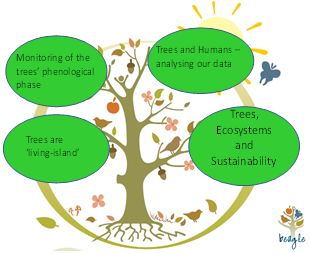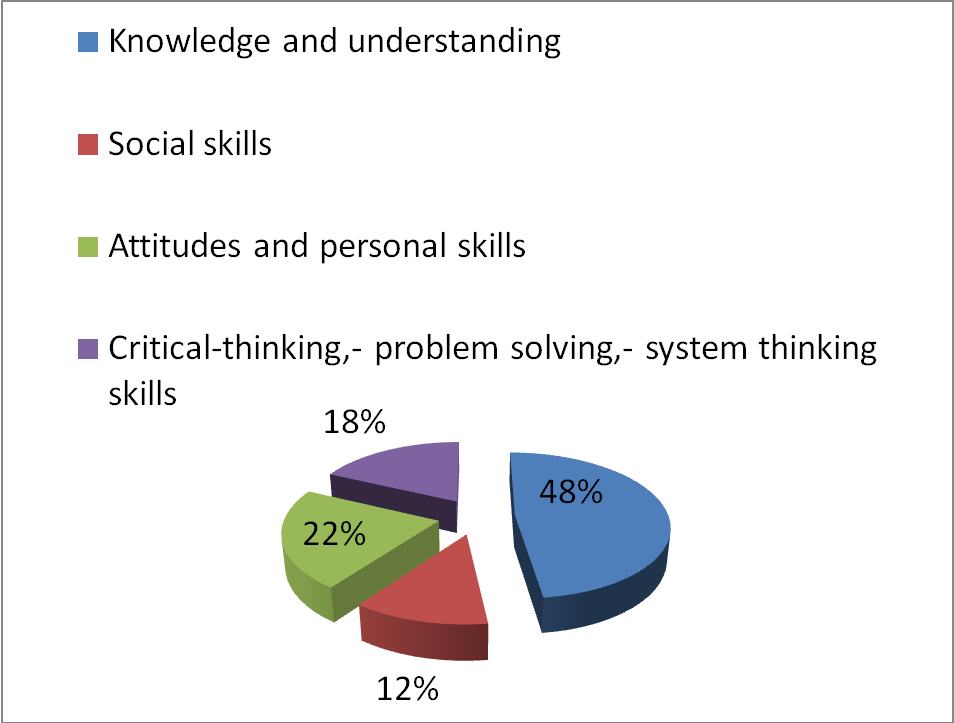IX. 3.2. Example of projects in environmental education by lower primary teacher training students
In our institute the training of lower primary teachers comprises two levels. The first level covers the basic education of lower primary teacher training; in this phase students obtain general, scientifically based training in all areas of sciences. From the second year on, parallel with the basic BA education, the second level is introduced with a specialisation in one of the main sciences whose terms and pedagogy are offered to students in various courses. The basic education of lower primary teachers prepares students to teach in the first four classes of primary schools. Their specialization prepares them to teach the first six classes in primary schools. This form of education is also beneficial for primary school pupils as the teacher monitors their achievements in the given subject until as late as the end of the 6th class. Thus the transition is smooth between lower primary education with only one teacher, and the upper primary education with many different teachers in the classroom.
On both levels of the training of lower primary teachers there are courses where comprehensive projects on environmental education are prepared and piloted by students. In my work I summarised and published the results of environmental projects done on the first level (Fűzné 2012.) The aim of the study was to analyse the pedagogy of project-work done by those lower primary school student-teachers who opted for studying natural sciences. In the related methodology course (in the fifth and sixth semesters) students elaborated and piloted four projects on environmental education. These projects were primarily done outdoors, in nature.
Projects for the outdoors
Four environmental projects have been compiled by 12 students of our course. These were as follows:
- BEAGLE
- Bird-friendly schoolyard
- Water
- Air
The first one of these four projects was financed by the European Union and the author of this study (Fűzné) also participated in its elaboration during 2008-2010. The aim of this project was to improve the knowledge of both teachers and students about biodiversity and sustainable development by providing electronic and printed educational materials and tools used in the education of biodiversity, in classes taught outdoors. The lower primary school student-teachers had an opportunity to get to know and try the BEAGLE (Biodiversity Education and Awareness to Grow a Living Environment) project in the form of out-of-school education.
What actions were taken in the BEAGLE project?
The main goal of the BEAGLE project was to improve the quality of learning outside of the classroom and enhance students’ motivation to learn, so that the capacity of people to live sustainable lives would improve.
Schools from six countries were invited to participate: Germany, Hungary, Norway, Poland, Slovakia and the United Kingdom. Each school carried out simple biodiversity observations based around trees and entered this information on to the BEAGLE project international (www.beagleproject.org) and national websites (www.mkne.hu). There were trees in each school ground or local park, that is why every student had a possibility to choose and monitor a tree near the school. The lower primary school student-teachers were monitoring six species of trees, which are listed below:
- Oak (Quercus sp.)
- Beech (Fagus sylvatica)
- Horse Chestnut (Aesculus hippocastanum)
- Birch (Betula sp.)
- Rowan (Sorbus aucuparia)
- Lime (Tilia sp.)
Information was gathered and consequences drawn to see how different stages of tree life-cycles take place across Europe throughout the year. Data were compared with former results and factors such as climate change to see the influence humans are having on the natural environment.
The overview of the main activities of the BEAGLE project can be summarised as follow:
1. Monitoring of the trees’ phenological phase (physiological change)
1.1.When did the buds burst on the tree?
1.2. When did the tree first flower?
1.3. When did the trees have their first leaves?
1.4. When were the berries ripe or when did the seeds develop?
1.5. When did the leaves start to fall?
1.6. When did all the leaves become brown or yellow (full tint)?
2. Trees and Humans – analysing our data
3. Trees, Ecosystems and Sustainability

Figure2. The overview of the main activities of the BEAGLE projects
Why did we study trees?
Trees are a vital part of our life support system and play a major role in maintaining the balance of the environment. Trees are ‘living-islands’ for many species and these features make them ideal objects for biodiversity monitoring projects. Trees provide a number of ecosystem services such as the conversion of carbon dioxide into oxygen and they minimise soil erosion. Without these services the lives we lead today would not be possible. Trees act as indicators of how the environment is changing. They are examples of sustainability and with such widespread presence across Europe they also provide us with ideas of how we can live sustainably.
Having tried themselves out in a given complete project (‘BEAGLE’), lower primary school student-teachers compiled and worked in three other projects: ‘Bird-friendly schoolyard’, ‘Water’, ‘Air’ in groups of four. There is a country-wide big project in Hungary called ‘Bird-friendly schoolyard’, which is coordinated by the Hungarian Ornithology and Nature Protection Association (by its Hungarian acronym MME). That is why the students were able to get additional information from this association’s website (for further details see: www.mme.hu). Water and air are fundamental for living creatures, including humans and that is why these topics provided excellent possibilities for students to study the complexity of nature. It was an optional possibility for our students to choose a topic (from the above) and then they were asked to form a group. The students first learnt about the most important steps and characteristics of project planning. The next step was to work in their teams. Each project had to include eight important elements:
- The description of the environmental issue in question
- Objectives
- Activities and procedure
- Subject areas (disciplines to which the activities of the project relate to)
- Materials
- Outputs
- Evaluation – assessment
- Resources
After lower primary school student-teachers planned their projects they had to present them. During the presentation peer students were observers, and their task was to evaluate the project they had observed. The criteria to consider were as follow:
- To what extent the project focuses on developing critical thinking skills
- To what extent the project is compatible with the environmental education curriculum (created for lower primary school pupils)
- To what extent the project is activity-based
- To what extent the project is self-contained
- To what extent the project is interdisciplinary
- To what extent the project is enjoyable for the participants (whether or not it includes exciting activities)
- To what extent the project is useful for every-day life (deals with real problems).
Project outcomes
After each project presentation we discussed the outcomes and I asked the students to give feedback and advice on how to improve the individual projects. We collected all these pieces of good advice and sent them to the groups concerned. Group members had to alter their project plans accordingly.
At the beginning of the methodology course we used semi-structured interviews to assess the pre-knowledge of students about projects in general and about their past experience with project work in particular. Participating students’ organisational skills for outdoor education were also evaluated.
The outcomes of the semi-structured interviews, done at the beginning of the methodology course, can be summarised as follows:
- Most lower primary school student-teachers think that learning about projects is the same as doing group work. (Project-work for them is identical with group-work.)
- Most lower primary school student-teachers believe that outdoor education is very useful for pupils and students, but they do not know how to organise an out-of-classroom learning experience for their pupils.
- Only a few lower primary school student-teachers had previously been participants in some kind of outdoor learning programme during their primary and secondary school studies. (On the other hand they had already been in study-trips, field-study programmes or forest-school programmes).
- Only two students had known about the ‘Bird-friendly schoolyard’ programme prior to our methodology course.
After the elaboration and implementation of the projects we used semi-structured interviews again to find out to what extent my students’ knowledge and skills improved by working on environmental projects.
The interview questions were as follow:
- Can you mention minimum three new elements you learnt during project work?
- How can you put the newly gathered information or your improved skills into your day - by - day practice?
- What can you do for the environment as a lower primary teacher?
After the interviews we divided the answers of students into four groups:
- Knowledge and understanding 48%
- Social skills 12%
- Attitudes and personal skills 22%
- Critical-thinking,- problem solving,- system thinking skills 18%

Figure3. Students’ answers
Some examples of the students’ responses:
1. Responses in relation to the category of ‘Knowledge and understanding’
“We need to change our approaches to how we live; we need to rethink how we can live on our planet and appreciate that it is to support us now and in the future. These new ways of thinking are named sustainability.”
“Trees represent small ecosystems. Trees have no mouths but they communicate daily with us. We should try to understand them, to recognize signals they are sending to us, we should learn lessons from their lives and behaviour and from what they mean for us.”
“If we compare the functioning of Nature and society, the conclusion is unambiguous because Nature’s systematic and purposeful; it represents higher order than our chaotic society, which is controlled by people. We have to learn from the physical and biotic environments because they do not produce waste.”
2. Responses in relation to the category of ‘Social skills’
“When I was working cooperatively with others I got good advice on how to collect relevant information and teaching-materials.”
“Creating and maintaining a bird-friendly school-yard is a wonderful way to encourage my pupils to spend more time outdoors. It does not only serve as a beautiful outdoor space, but also as a centre for learning.
“Information and education are needed to help people optimise the use of natural resources.”
3. Responses in relation to the category ‘Attitudes and personal skills’
“There are several ways to help the environment. For example: I buy only as much as I need. If I use energy-saving bulbs, they consume only one-fourth of the energy to generate the same amount of light and they last up to 10 times longer.”
“I use my bike regularly because it is one of the most environmentally friendly means of transport.”
4. Responses in relation to the category ‘Critical-thinking, problem solving, system thinking skills’
“Air and water pollution dramatically affect biodiversity and the conditions of ecosystems, including forest and crops”
“I stop before throwing something away and I ask myself: ‘Can I reuse it? If I cannot reuse it, can someone else? If it cannot be reused by anyone can it be recycled?”
“I practised and improved my critical thinking when we used the dilemma cards.”
Question
How would you explain the results of responses shown above?